Search the Special Collections and Archives Portal
Search Results
Howard Hughes's XF-11 near Culver City, California, 1946
Level of Description
File
Archival Collection
Howard Hughes Public Relations Photograph Collection
Pagination
- Previous page ‹‹
- Page 11
Archival Component
Howard Hughes's XF-11 near Culver City, California, 1946
Level of Description
File
Archival Collection
Howard Hughes Public Relations Photograph Collection
Pagination
- Previous page ‹‹
- Page 11
Archival Component
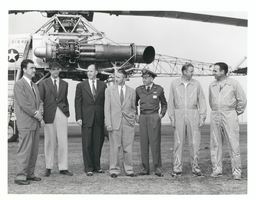
Photograph of Howard Hughes with XH-17 helicopter, Culver City, California, October 23, 1952
Date
1952-10-23
Archival Collection
Description
L-R: Rea Hopper, Director of the Aeronautical Division, Hughes Aircraft Company; Howard Hughes; Clyde Jones, Director of Engineering, Hughes Tool Company Aeronautical Division; Warren Reed, Assistant; Col. Carl E. Jackson, Air Research and Development Headquarters, Baltimore; Gale J. Moore, pilot; and unidentified pilot in front of the experimental helicopter XH-17 Flying Crane on October 23, 1952. This was one of Hughes' last public appearances.
Image
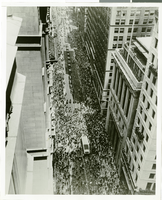
Photograph of a parade for Howard Hughes, New York City, July 15, 1938
Date
1938-07-15
Archival Collection
Description
Typed onto a piece of paper attached to the image: "New York Acclaims World Fliers, New York City --- Looking up Broadway during the ticker-tape reception accorded Howard Hughes and his four companions in recognition of their Round-The-World record-smashing flight. The dense crowd which lined both sides of the through fare has closed in behind the parade, while further ahead fresh showers of torn paper flutter down on the motorcade. 7(3/4)-15-38. Credit Line (ACME)."
Image
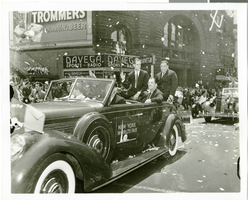
Photograph of Howard Hughes at his parade for Round the World flight, New York City, July 15, 1938
Date
1938-07-15
Archival Collection
Description
The black and white view of Howard Hughes (waving) seated in an automobile that was used in a parade dedicated to Hughes' completion of his Round the World flight in New York City, New York.
Image
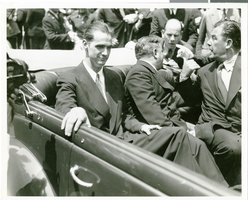
Photograph of Howard Hughes at his parade for Round the World flight, New York City, July 15, 1938
Date
1938-07-15
Archival Collection
Description
The black and white view of Howard Hughes, Mayor La Guerdia, and Grover Whalen leaving City Hall through a parade dedicated to the completion of Hughes' Round the World flight in New York City, New York.
Image
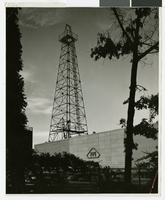
Photograph of the exterior of Hughes Research Laboratories, Culver City, California, circa 1940s
Date
1940 to 1949
Archival Collection
Description
The exterior of Hughes Research Laboratories where rock bits were test-drilled in Culver City, California in the 1940s. Transcribed from note taped to back of photo: "Rock bits are test-drilled in the laboratory under conditions that duplicate, as far as is possible in the laboratory, those encountered in actual drilling. As a result, rotational speeds, loads, and fluid volume are closely controlled. The rig operator occupies a splash-proof booth above the 'cellar floor.' The instruments on his control panel provide for application and measurement of variable axial loading on the drilling bit up to 100,000 lbs., variable rotational speeds up to 400 rpm, measurement of bit penetration over a total vertical travel of 5 feet at rates up to 180 ft. per hour, and torque. On the panel, also, are several controls for the operation of mud pump and other accessory equipment."
Image
Howard Hughes and others inside City Hall in New York City, New York, 1938 July 15
Level of Description
File
Archival Collection
Howard Hughes Public Relations Photograph Collection
Pagination
- Previous page ‹‹
- Page 11
Archival Component
Howard Hughes and others inside City Hall in New York City, New York, 1938 July 15
Level of Description
File
Archival Collection
Howard Hughes Public Relations Photograph Collection
Pagination
- Previous page ‹‹
- Page 11
Archival Component
Howard Hughes and his crew on the steps of City Hall for photographs in New York City, 1938 July 15
Level of Description
File
Archival Collection
Howard Hughes Public Relations Photograph Collection
Pagination
- Previous page ‹‹
- Page 11
Archival Component
Pagination
Refine my results
Content Type
Creator or Contributor
Subject
Archival Collection
Digital Project
Resource Type
Year
Material Type
Place
Language
Records Classification
